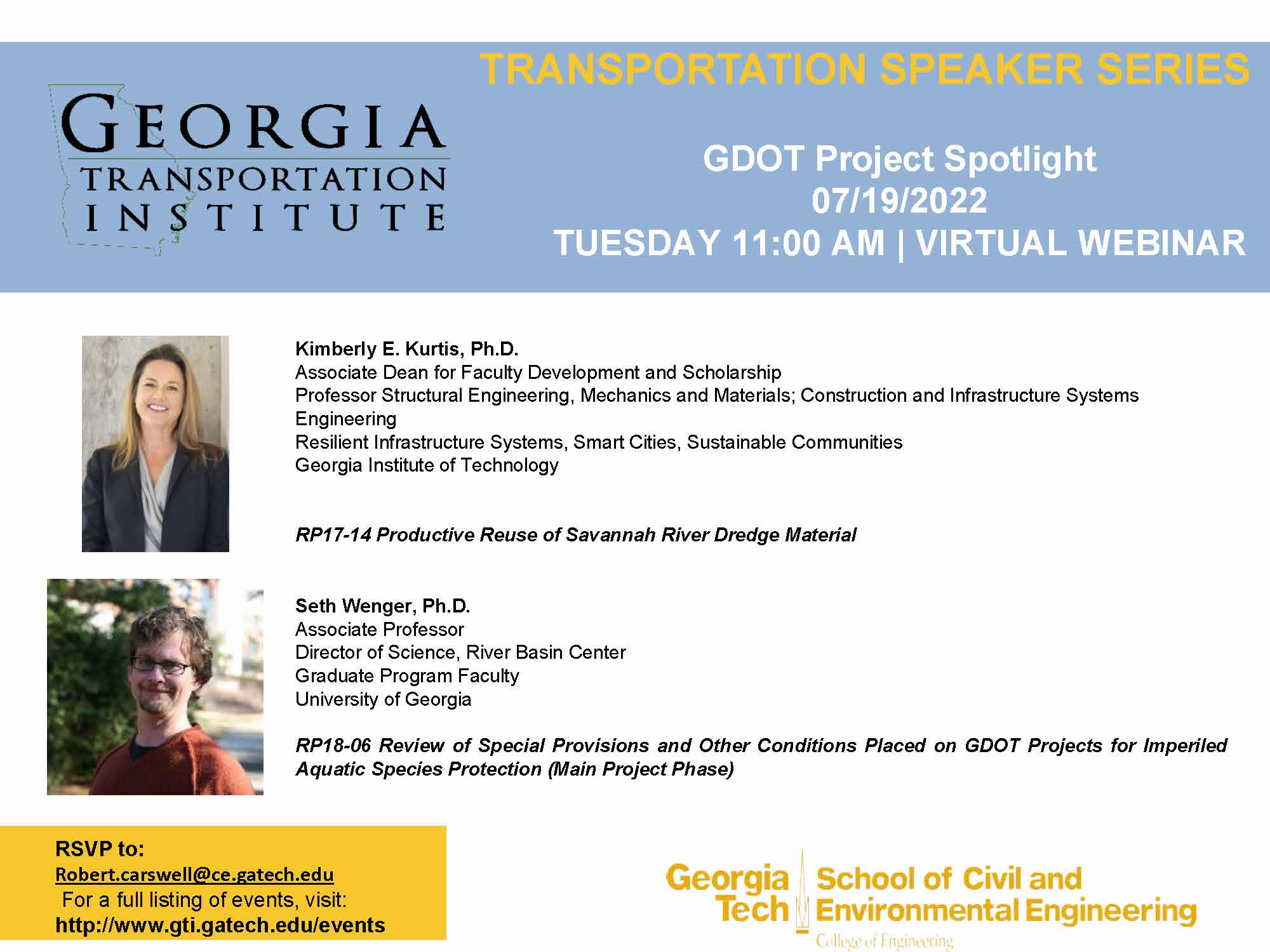GDOT/GTI - Project Spotlight July 2022
Tuesday 19th, the Georgia Transportation Institute will hosted a 1-hour webinar that spotlighted three recently completed GDOT Research projects. Each project had maximum of a 15-minute presentation, with a short time afterward for questions.
You can join the event by using the Microsoft Teams link below:

Presenter: Kimberly E. Kurtis, Ph.D., Associate Dean for Faculty Development and Scholarship
Professor Structural Engineering, Mechanics and Materials; Construction and Infrastructure Systems Engineering
Resilient Infrastructure Systems, Smart Cities, Sustainable Communities Georgia Institute of Technology
Dr. Kimberly (Kim) E. Kurtis is a Professor in the School of Civil and Environmental Engineering at the Georgia Institute of Technology. She has served as Associate Dean of Faculty Development and Scholarship in the College of Engineering since 2014 and was interim chair of the School for the 2017-2018 academic year. Dr. Kurtis earned her BSE in civil engineering from Tulane University under a Dean's Honor Scholarship and her Ph.D. in civil engineering from the University of California at Berkeley, where she was a Henry Hilp Fellow and a National Science Foundation (NSF) Fellow. Dr. Kurtis’s innovative research on the multi-scale structure and performance of cement-based materials has resulted in more than 100 technical publications and two US patents. In addition to her technical and educational service contributions at the American Concrete Institute (ACI), American Ceramics Society (ACerS), Portland Cement Association (PCA), Transportation Research Board (TRB), American Association of State and Highway Transportation Officials (AASHTO), and Federal Highway Administration (FHWA), she has held two leadership positions – Chairman of ACI Committee 236: Materials Science of Concrete (2006-2012) and Chair of American Ceramic Society’s Cements Division (2008-2009) – central to advancing science-based research on cement-based materials. Dr. Kurtis has served as Associate Editor of ASCE Journal of Materials in Civil Engineering and as an Editorial Board member of Cement and Concrete Composites. Having previously served six years on ACI's Educational Activities Committee (EAC), she is currently appointed to ACI's 12-member Technical Activities Committee, which oversees the development of ACI standards, technical committee activities, and technical content presented at ACI conventions and in archival publications. Since 2018, she has been a Trustee at the ASCE Foundation, representing District 5. She has been honored with ACI’s Walter P. Moore, Jr. Faculty Achievement Award (2005), ACI’s Del Bloem Award for Service (2013), Outstanding Senior Undergraduate Research Mentor Award at Georgia Institute of Technology (2013), the ACI James Instruments Award for Research on NDE of Concrete (2008), Award for Outstanding Article in ASTM’s Journal of Testing and Evaluation (2010), and ASCE’s Huber Civil Engineering Research Prize (2013). Dr. Kurtis is a Fellow of the American Concrete Institute and the American Ceramics Society.
Title: GDOT RP17-14 Productive Reuse of Savannah River Dredge Material
Abstract:
The Port of Savannah is located 18 miles inland from the Atlantic Ocean in the southeastern United States. Historically, 6 million cubic meters of river sediment is dredged from the Savannah River each year; however, the Savannah Harbor Expansion Project (SHEP) (Georgia, USA), which is proposed to accommodate post Panamax ships in the channel, will result in further increased dredge volume for disposal. Because dredge materials are currently disposed of on land, this study was focused on identifying possible beneficial uses of dredged material to reduce the requirements for land disposal. A laboratory-based study was performed to assess the feasibility of large volume geotechnical use options for dredged sediments. Four samples were collected from the disposal facilities and characterized using physical, chemical, and morphological analysis techniques, including grain size distribution, Atterberg limits test, specific gravity, scanning electron microscopy (SEM), laser diffraction particle size analysis (PSA), total organic carbon content (TOC), loss on ignition (LOI), and thermogravimetric analysis (TGA) analysis. The compactibility of the dredge was quantified using the standard Proctor test. Overall, characterization and compaction results demonstrated that the dredge material is viable for use as a nonstructural fill material, indicating that additional research and feasibility studies focused on specific beneficial use options are warranted. These results have important implications on the potential for beneficial use of the dredged sediment.
Presenter: Seth Wenger, Ph.D., Associate Professor Director of Science, River Basin Center
Graduate Program Faculty
University of Georgia
Title: RP18-06 Review of Special Provisions and Other Conditions Placed on GDOT Projects for Imperiled Aquatic Species Protection (Main Project Phase)
Abstract:
Georgia has numerous protected freshwater species, which means that the Georgia Department of Transportation (GDOT) must frequently consult with federal and state agencies to identify measures to avoid, minimize and mitigate impacts on imperiled aquatic organisms. Some of these measures, such as restrictions on in-water work during the reproductive season, impose substantial costs on GDOT projects, but their efficacy has not been thoroughly evaluated. The current system also provides limited flexibility. The research team has developed a system for assessing the impact of road construction projects on imperiled freshwater species that accounts for project characteristics, site characteristics, and species sensitivity. Called the “Total Effect Score” (TES), it is based on a comprehensive assessment of the tolerances and traits of 111 freshwater species and a thorough review of the literature on the efficacy of construction and post-construction BMPs. It employs a risk-based system to assess construction-phase effects and post-construction effects over a 50-year time horizon, making it possible to identify tradeoffs among alternative management practices. Additionally, the research team developed a template for a programmatic agreement (PA) that uses the TES as the basis for a streamlined system for evaluating projects. The PA is intended to cover both informal and formal consultation under a single system, which should reduce consultation time and increase predictability. To support the adoption of the PA, the research team conducted a biological assessment of all species. Adoption of the PA and the TES system should provide substantial cost savings for GDOT while improving outcomes for federally and state-protected freshwater species.
Theme by Danetsoft and Danang Probo Sayekti inspired by Maksimer


































